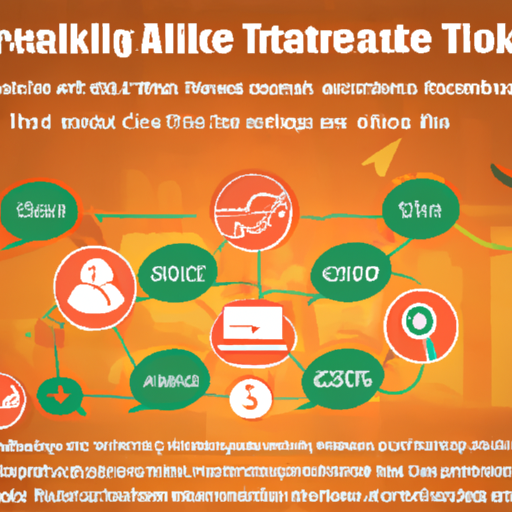When it comes to affiliate marketing, it’s essential to keep track of the right metrics to optimize your performance and maximize your earnings. After all, understanding how your marketing efforts are performing can make a significant difference in your success. In this article, we’ll dive into the key metrics you need to track in affiliate marketing, so you can make informed decisions and achieve your goals.
How to Make Money with YouTube
Create an empire of automated video websites for multiple streams of income
One of the most important metrics to monitor is click-through rate (CTR). This measures the percentage of people who click on your affiliate links compared to the total number of impressions. A high CTR indicates that your marketing message is resonating with your audience, while a low CTR may indicate that you need to refine your approach. By tracking your CTR, you can identify which affiliate links are most effective at driving traffic and adjust your marketing strategy accordingly.
Another crucial metric in affiliate marketing is conversion rate. This measures the percentage of visitors who complete a desired action, such as making a purchase or signing up for a newsletter, after clicking on your affiliate links. A high conversion rate indicates that your marketing efforts are successfully driving actions, while a low conversion rate may indicate that you need to optimize your landing pages or re-evaluate your affiliate offers. By tracking your conversion rate, you can identify areas for improvement and make changes to increase your effectiveness.
Lastly, don’t forget to pay attention to the average order value (AOV). This metric measures the average amount of money customers spend each time they make a purchase through your affiliate links. A higher AOV means that you are generating more revenue per sale, which can significantly impact your overall earnings. By tracking your AOV, you can identify opportunities to upsell or cross-sell products, ultimately increasing your commission per sale.
In this article, we’ve covered some of the key metrics you need to track in affiliate marketing, including click-through rate, conversion rate, and average order value. By regularly monitoring and analyzing these metrics, you can make data-driven decisions to optimize your performance and achieve your affiliate marketing goals. Keep reading to learn more about how to effectively track and analyze these metrics and take your affiliate marketing efforts to the next level.
Defining Affiliate Marketing
Affiliate marketing is a popular form of performance-based marketing where individuals or businesses, known as affiliates, promote products or services of another company and earn a commission for every sale or transaction made through their referral. It is a win-win situation for both the affiliate and the company as the affiliate gets to earn a passive income while the company gets increased sales and brand exposure.
Understanding the concept of affiliate marketing
Affiliate marketing operates on the principle of revenue sharing. Affiliates promote products or services through their own marketing efforts, such as blog posts, social media, or email marketing. When a customer makes a purchase or completes a desired action (such as signing up or filling out a form) through the affiliate’s unique tracking link, the affiliate earns a commission.
How affiliate marketing works
Affiliate marketing works through a three-way partnership between the affiliate, the merchant (the company whose products or services are being promoted), and the affiliate network (a platform that connects affiliates with merchants). The affiliate network serves as an intermediary, providing tracking technology, support, and payment processing.
Affiliates sign up for affiliate programs offered by merchants through the affiliate network. They receive unique tracking links or codes that they can use to promote the merchant’s products or services. These tracking links allow the affiliate network to track and attribute sales or actions back to the respective affiliate.
Benefits of affiliate marketing
Affiliate marketing offers several benefits for both affiliates and merchants. For affiliates, it provides an opportunity to earn passive income by promoting products or services they believe in. They can choose from a wide range of products or services to promote, allowing them to align their promotions with their interests or target audience.
For merchants, affiliate marketing provides a cost-effective way to reach a wider audience and drive sales. They only pay a commission when a sale or desired action is achieved, making it a performance-based marketing strategy. It also allows them to tap into the marketing expertise and reach of affiliates, extending their brand exposure and customer base.
Importance of Tracking Metrics in Affiliate Marketing
Tracking metrics is crucial in affiliate marketing as it provides insights into the performance and profitability of affiliate campaigns. By monitoring and analyzing key metrics, affiliates and merchants can make data-driven decisions, optimize their strategies, and maximize their return on investment (ROI).
Why tracking metrics is crucial in affiliate marketing
Tracking metrics allows affiliates and merchants to measure the success of their affiliate campaigns. It provides valuable data on various aspects of the campaign, such as click-through rates (CTR), conversion rates, average order value (AOV), ROI, and more. Without tracking metrics, it becomes challenging to determine which strategies are effective and which ones need improvement.
Effective decision-making through metric analysis
Analyzing metrics helps affiliates and merchants make informed decisions about their marketing strategies. It allows them to identify what is working and what is not, enabling them to adjust their tactics accordingly. For example, if a specific promotional method or affiliate is consistently driving high conversion rates, the affiliate or merchant can focus more resources on that particular strategy or affiliate.
Maximizing ROI through metric optimization
Tracking metrics enables affiliates and merchants to optimize their campaigns for maximum ROI. By analyzing data on conversion rates, click-through rates, and average order value, they can identify areas of improvement and implement targeted strategies to enhance performance. This could involve refining targeting, improving website design and user experience, or creating compelling content that resonates with the target audience.

Key Metrics to Track in Affiliate Marketing
In affiliate marketing, there are several key metrics that affiliates and merchants should track to measure the success of their campaigns and identify areas for improvement. These metrics provide valuable insights into customer behavior, campaign performance, and overall profitability.
Click-Through Rate (CTR)
The click-through rate measures the percentage of people who click on an affiliate’s promotional link or banner compared to the total number of impressions or views. A high CTR indicates that the affiliate’s promotion is compelling and is generating interest among the audience. It is a measure of the effectiveness of the affiliate’s marketing efforts in driving traffic to the merchant’s website.
Conversion Rate
The conversion rate measures the percentage of people who complete a desired action, such as making a purchase or signing up, compared to the total number of clicks or visits. A high conversion rate indicates that the affiliate’s efforts are resulting in actual sales or desired actions. It is a critical metric for evaluating the effectiveness of the affiliate’s promotional tactics and the merchant’s landing pages or checkout process.
Average Order Value (AOV)
The average order value measures the average amount spent by customers on each transaction. It provides insights into customer spending behavior and the potential for upselling or cross-selling. By increasing the average order value, affiliates and merchants can increase their revenue without necessarily acquiring more customers.
Return on Investment (ROI)
The return on investment measures the profitability of an affiliate campaign by comparing the amount spent on marketing efforts to the revenue generated. It helps affiliates and merchants assess the financial viability of their campaigns and allocate resources accordingly. A positive ROI indicates that the campaign is generating more revenue than the marketing expenses, while a negative ROI signals the need for adjustments to improve profitability.
Earnings per Click (EPC)
The earnings per click metric measures the average earnings generated for each click on the affiliate’s promotional link. It provides insights into the revenue potential of each click and helps affiliates compare the performance of different campaigns or promotional methods. A higher EPC is indicative of more lucrative affiliate offers or higher converting traffic sources.
Reversal Rate
The reversal rate measures the percentage of commissions that are reversed or canceled due to refunds or chargebacks. It is an important metric for tracking the quality of the products or services being promoted. A high reversal rate may indicate product dissatisfaction or issues with the merchant’s customer service, while a low reversal rate suggests satisfied customers and reliable commissions.
Customer Acquisition Cost (CAC)
The customer acquisition cost measures the average cost of acquiring a new customer. It factors in all the marketing expenses, such as advertising costs, affiliate commissions, and other promotional expenses, divided by the number of new customers acquired. By tracking CAC, affiliates and merchants can assess the efficiency of their marketing efforts and make informed decisions about resource allocation.
Lifetime Value (LTV)
The lifetime value represents the estimated revenue generated by a customer over their entire relationship with the merchant. It helps affiliates and merchants understand the long-term profitability of their customer base, allowing them to focus on acquiring and retaining high-value customers. By improving customer retention and increasing cross-selling or upselling opportunities, affiliates and merchants can increase their overall LTV.
Attribution
Attribution is the process of assigning credit to different touchpoints or marketing channels that contributed to a conversion or sale. It helps affiliates and merchants understand the customer journey and allocate resources effectively. By knowing which channels or affiliates drive the most conversions, they can optimize their promotional strategies and improve ROI.
Engagement Metrics
Engagement metrics, such as time on site, bounce rate, or pages per visit, measure the level of interaction and interest visitors have with the merchant’s website. These metrics provide insights into the effectiveness of the affiliate’s promotional methods and the user experience provided by the merchant. By improving engagement metrics, affiliates and merchants can increase the chances of conversions and revenue generation.
Analyzing Click-Through Rate (CTR)
The click-through rate is a key metric in affiliate marketing as it indicates the effectiveness of an affiliate’s promotional efforts in generating interest among the audience and driving traffic to the merchant’s website. A high CTR signifies that the affiliate’s promotion is compelling and enticing enough to attract clicks.
Understanding the significance of CTR
A high CTR translates to more traffic and potential customers visiting the merchant’s website. It indicates that the affiliate’s marketing efforts are resonating with the target audience and successfully capturing their attention. A low CTR, on the other hand, suggests that the affiliate’s promotional methods may need improvement or optimization.
Factors influencing CTR
Several factors influence the CTR of an affiliate’s promotional efforts. These include the quality and relevance of the promotional content, the positioning and visibility of the promotional links or banners, the trust and credibility of the affiliate’s brand or platform, and the alignment between the affiliate’s target audience and the merchant’s offerings.
Optimizing CTR for better results
To optimize CTR, affiliates can focus on creating compelling and persuasive promotional content that resonates with their target audience. They can strategically position the promotional links or banners within their content, leveraging eye-catching visuals or persuasive call-to-actions. It is also important to continually test and refine promotional methods to identify what works best for the specific audience and niche.

Measuring Conversion Rate
The conversion rate is a critical metric in affiliate marketing as it measures the percentage of people who complete a desired action, such as making a purchase or signing up, compared to the total number of clicks or visits. It provides insights into the effectiveness of the affiliate’s promotional tactics and the merchant’s landing pages or checkout process.
Why conversion rate is important
The conversion rate is a direct indicator of the performance and success of an affiliate’s efforts in driving actual sales or desired actions. A high conversion rate indicates that the affiliate’s promotional methods are compelling and persuasive enough to convert visitors into customers. It signifies that the affiliate has successfully guided the audience through the sales funnel and influenced their purchasing decision.
Optimizing conversion rate
To optimize the conversion rate, affiliates can focus on several strategies. Firstly, they can ensure that the landing pages or sales pages they are driving traffic to are user-friendly, visually appealing, and optimized for conversions. Secondly, clear and persuasive call-to-actions should be utilized to encourage visitors to take the desired action. Additionally, offering incentives or exclusive discounts can entice visitors to complete a purchase.
Analyzing and tracking conversion rate data
Tracking conversion rate data allows affiliates to identify trends, patterns, or areas for improvement in their promotional tactics. They can compare the performance of different campaigns, promotional methods, or traffic sources to determine what drives the highest conversion rates. This data-driven approach enables affiliates to allocate their resources effectively and focus on strategies that generate the most conversions.
Examining Average Order Value (AOV)
Average Order Value (AOV) is an important metric for affiliates and merchants as it measures the average amount spent by customers on each transaction. It provides insights into customer spending behavior and the potential for upselling or cross-selling.
Understanding the role of AOV in affiliate marketing
AOV helps affiliates and merchants determine the revenue generated from each customer transaction. It can help identify opportunities for increasing revenue without necessarily acquiring more customers. By focusing on increasing the average order value, affiliates and merchants can optimize their marketing tactics to drive higher-value transactions.
Increasing AOV for higher profits
To increase AOV, affiliates can employ various strategies. Cross-selling complementary products or upselling higher-priced items are effective ways to encourage customers to spend more. Offering incentives, such as free shipping for purchases above a certain threshold or bundling products together, can also increase the likelihood of customers spending more per transaction.
Analyzing AOV trends
Analyzing AOV trends allows affiliates and merchants to assess the effectiveness of their upselling or cross-selling strategies. It helps identify which products or offers drive higher order values and which ones may need adjustment. By monitoring AOV over time, affiliates and merchants can make data-driven decisions to optimize their marketing efforts and maximize their revenue potential.
Calculating Return on Investment (ROI)
Return on Investment (ROI) is a crucial metric in affiliate marketing that measures the profitability of an affiliate campaign. By comparing the amount spent on marketing efforts to the revenue generated, affiliates and merchants can assess the financial viability of their campaigns and make informed decisions about resource allocation.
Importance of tracking ROI
Tracking ROI allows affiliates and merchants to evaluate the financial success of their campaigns. It helps determine whether the revenue generated is higher than the expenses incurred. By understanding the ROI, affiliates and merchants can identify which campaigns or promotional methods are generating the highest returns and scale them accordingly.
Evaluating campaign success through ROI
ROI serves as an essential benchmark for evaluating the success of affiliate marketing campaigns. A positive ROI indicates that the campaign is generating more revenue than the marketing expenses, making it a profitable venture. On the other hand, a negative ROI highlights the need for adjustments or optimization to improve profitability.
Optimizing ROI through performance analysis
To optimize ROI, affiliates and merchants can analyze campaign performance data to identify areas for improvement. They can assess the performance of different traffic sources, promotional methods, or offers to determine which ones generate the highest ROI. By allocating resources to high-performing campaigns and adjusting or discontinuing low-performing ones, affiliates and merchants can maximize their profitability.
Evaluating Earnings per Click (EPC)
Earnings per Click (EPC) is a performance metric in affiliate marketing that measures the average earnings generated for each click on an affiliate’s promotional link. It provides insights into the revenue potential of each click and helps affiliates compare the performance of different campaigns or promotional methods.
Understanding EPC as a performance metric
EPC helps affiliates assess the potential profitability of their promotional efforts and compare the performance of different campaigns or offers. A higher EPC indicates that the affiliate’s efforts are lucrative and resulting in higher earnings per click.
Factors affecting EPC
Several factors can influence EPC, including the quality and relevance of the promotional content, the conversion rate of the merchant’s website, the average order value, the commission structure, and the affiliate’s promotional methods. Affiliates should focus on promoting high-converting offers with attractive commission rates to maximize their EPC.
Improving EPC through strategy and targeting
To improve EPC, affiliates can refine their promotional strategies and target audience. Creating compelling content, utilizing persuasive call-to-actions, and targeting the right audience can result in higher conversion rates and ultimately increase the average earnings per click. Additionally, negotiating higher commission rates with merchants for high-performing campaigns can positively impact EPC.
Analyzing Reversal Rate
Reversal rate is a metric in affiliate marketing that measures the percentage of commissions that are reversed or canceled due to refunds or chargebacks. It is an important metric for tracking the quality of the products or services being promoted and minimizing the risk of commission loss.
Defining reversal rate in affiliate marketing
Reversal rate represents the percentage of commissions that are canceled or reversed due to various factors, such as product returns, cancellations, or chargebacks. It is a measure of the quality and customer satisfaction of the products or services being promoted. A high reversal rate indicates potential issues with the merchant’s offerings or customer service.
Understanding its impact on profitability
A high reversal rate can significantly impact the profitability of an affiliate campaign. Affiliates may lose commissions on sales that are later reversed, resulting in reduced earnings. It is crucial for affiliates to promote high-quality products or services and align themselves with reputable merchants to minimize the risk of commission loss.
Strategies to reduce reversal rate
To reduce the reversal rate, affiliates can focus on promoting products or services with positive customer reviews and a reputation for high customer satisfaction. They can provide accurate and detailed information about the products or services to set realistic expectations for potential customers. Effective communication with the merchant’s customer service team can also help resolve any issues promptly and prevent unnecessary cancellations or refunds.
Conclusion
In conclusion, tracking key metrics is essential in affiliate marketing to measure performance, make data-driven decisions, and maximize profitability. Metrics such as click-through rate, conversion rate, average order value, return on investment, earnings per click, reversal rate, customer acquisition cost, lifetime value, attribution, and engagement metrics provide valuable insights into the success of affiliate campaigns and the behavior of customers.
By analyzing and optimizing these metrics, affiliates and merchants can enhance their marketing strategies, allocate resources effectively, and continuously improve performance. The ability to track and measure key metrics empowers affiliates and merchants to make informed decisions and achieve long-term success in the dynamic and competitive world of affiliate marketing. So, start tracking your metrics today and take your affiliate marketing efforts to new heights!






